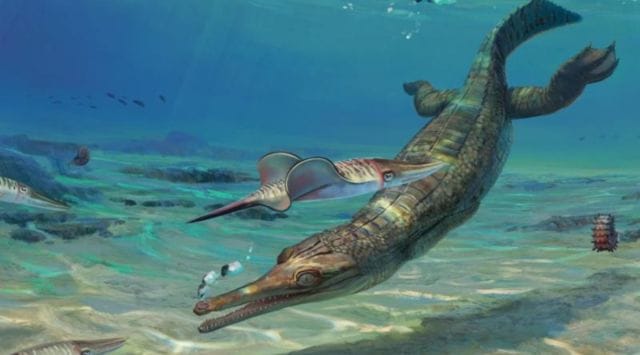Newly-discovered ancient ‘marine crocodile’ fossil could be the oldest of its kind ever found
Scientists have uncovered a new thalattosuchian—an ancient “cousin” of modern-day crocodiles—which could be the oldest of its kind ever discovered. The newly-discovered fossil could help fill a gap in the fossil record of these animals.
 Artist's impressions of Turnersuchus hingleyae. (Image credit: Júlia d'Oliveira / Taylor & Francis)
Artist's impressions of Turnersuchus hingleyae. (Image credit: Júlia d'Oliveira / Taylor & Francis) Palaeontologists have uncovered a new Thalattosuchian—an ancient “cousin” of modern-day crocodile—which could be the oldest of its kind ever discovered, according to a recent study published by Taylor & Francis. The fossils uncovered on the Jurassic Coast in the United Kingdom include part of the head, backbone, and limbs of Turnersuchus hingleyae.
The newly-discovered fossils of Turnersuchus hingleyae represent the only complete Thalattosuchian of its age and date back to the early Jurassic, Pliensbachian period, which was about 185 million years ago. In the study published in Journal of Vertebrate Paleontology, the researchers stated that the discovery of this new fossil helps fill a gap in the fossil record and suggests that Thalattosuchians and other crocodile-like animals could have originated around 15 million years farther than Turnersuchus.
“We should now expect to find more Thalattosuchians of the same age as Turnersuchus as well as older. I expect we will continue to find more older Thalattosuchians and their relatives. Our analyses suggest that Thalattosuchians likely first appeared in the Triassic and survived the end-Triassic mass extinction,” said Eric Wilberg, co-author of the study, in a press statement.
But, no expedition has found Thalattosuchians in Triassic rockets yet, which according to Taylor & Francis, means that there is a ghost lineage. This means there is a group that scientists know existed, but they do not yet have fossil evidence. Until the discovery of the latest fossil, this ghost lineage extended from the end of the Triassic period till the Toarcian period. But now, it has been reduced by a few million years.
Due to their relatively long, slender snouts, it is likely that they would have looked similar to the currently living gharial crocodiles. Gharial crocodiles are usually found in the major river systems of Northern India. But according to the researchers, though thalattosuchians’ skulls looked similar to gharial crocodiles, they were constructed differently.
The region of the skull housing jaw muscles was particularly large in the species, suggesting that they had enlarged jaw muscles that made fast bites possible. This would have been useful considering that most of their prey were probably fast-moving fish and cephalopods like squids and octopuses.







